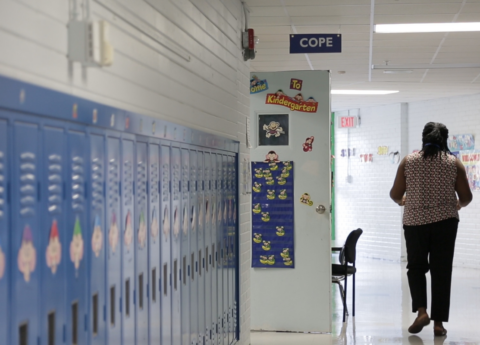In 1991, following a Kentucky Supreme Court decision finding that Kentucky’s system of funding education was unconstitutional, the Kentucky General Assembly responded by increasing taxes to begin reinvesting in Kentucky’s public schools. At the same time, the General Assembly established a formula to equalize funding among school districts, requiring districts to levy taxes at a minimum level, and providing more state funding to districts that have less capacity to raise revenues locally because of smaller tax bases. The funding and new formula put Kentucky on the forefront of education finance nationally and for years, Kentucky was steadily improving its ranking in many areas.
But as state revenue growth failed to keep pace with the economy due primarily to session after session of new tax cuts, exemptions and preferences leaving a shortage of revenues, the commitment to adequately and equitably funding P-12 education faded. With state support diminished, the burden has shifted over time so that local districts are shouldering more of the cost, leading once again to increasing inequities among districts — almost at the level they were when the funding system was declared unconstitutional back in 1990.
2022 presents a historic opportunity to reinvest
This year, the General Assembly will enact a budget for the 2022-24 biennium, and for the first time in many years, there are extra recurring revenues that provide an opportunity for legislators to begin reinvesting in areas that have been sorely underfunded. Restoring funding for P-12 education should be a top priority. Both the budget passed by the House and the budget proposed by the Governor increase funding for P-12 education; however, they differ substantially in amount and focus, with the Governor’s proposed budget providing significantly more than the budget passed by the House. The budget passed by the house left over $1.1 billion unappropriated, which means there is plenty of room to do more for our schools, teachers and students.
P-12 public school funding through the SEEK formula has deeply eroded
In looking specifically at funding for P-12 education in the current year, there has been a significant injection of one-time federal funds that have and will continue to be helpful to districts in addressing COVID-19 related needs. But this funding should not in any way divert attention from the fact that core state funding for Kentucky schools has continued to decline over the past several years, making it increasingly difficult for school districts to hire and retain staff, and to meet the growing needs of students.
The largest component of education funding is through the Support Education Excellence in Kentucky (SEEK) formula, which provides state funding to school districts based on wealth and local effort. SEEK includes a “base guarantee” for every student that is established in the budget. In the current budget, the base guarantee is $4,000, where it has remained since 2019. The SEEK formula also includes additional funds (referred to as “add-ons”) for students eligible for free lunches, students with disabilities, students with “limited English proficiency,” and home and hospital services (which have not been reviewed or adjusted since they were established despite increased costs associated with providing these services), in addition to transportation, which will be discussed in more detail below.
The base guarantee is funded through a combination of state and local funds, with the state contributing more to districts that have less property wealth, and therefore less ability to raise revenues locally. The portion the state pays on a per-pupil basis declined by $191 between 2008 and 2022, while the local portion grew by $369. Thus, the cost of the nominal increase in base funding is being borne primarily by local school districts. In addition, these numbers do not account for inflation. When inflation is factored in, as shown in the graph below, the per-pupil guarantee is lower in 2022 than it was in 2008 by $682 per student, a decline of 26.1%, with the state’s per-pupil contribution $921 lower than it was. Thus, despite claims that state support for education is increasing to historic levels, the amount the state is contributing to the base SEEK formula has actually declined in both real dollars, and when adjusted for inflation.
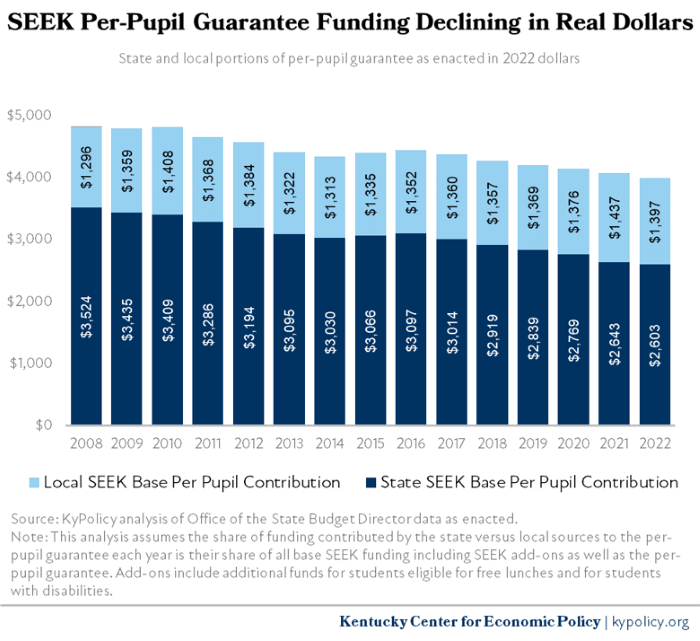
Increases in base SEEK funding in current budget proposals
The Governor’s proposed budget for 2022-24 increases the base guarantee to $4,300 in 2023 and $4,500 in 2024, while the budget passed by the House increases the per-pupil guarantee to $4,100 in 2023 and $4,200 in 2024. These differences are critical. SEEK funding largely provides the resources districts and schools have to pay staff, keep classroom sizes manageable, to hire math and reading interventionists, to maintain instructional time and other critical facets of educating our students and making educators jobs sustainable.
Both budgets also continue what was a bright spot for education in 2021 with funding for full-day Kindergarten for the 2022-24 biennium. (These funds were not included as part of the SEEK base for the current school year, but will be going forward.) The Governor’s proposed budget also provides $172 million for universal preschool for all 4-year olds but the House budget does not. Research shows clear benefits of preschool on language, literacy and mathematics skills.
Transportation costs are underfunded
Although technically part of SEEK, transportation funding is calculated separately and is one area where the shift in costs from the state onto local school districts is especially pronounced. By statute, the state is required to cover 100% of the estimated costs of transportation (which is less than the full cost of transportation as defined by the statute). However, the state has not been making this contribution for a number of years, and the current budget covers just 55% of the estimated costs in 2022, which means that school districts must make up the difference with local funds.
Increases in transportation funding in current budget proposals
In his proposed budget for 2022-24, the Governor fully funds transportation by including an additional $175 million in each year. The budget passed by the House for 2022-24 increases transportation funding by $60 million in each year, but divides the increased amount equally among districts, resulting in some districts receiving 100% of formula funding, while others receive as little as 70%. When districts have to spend more on transportation, they have less to spend on other critical supports for students and educators.
Inadequate funding has resulted in cuts, and teacher pay has not kept up with inflation
While poorer districts have been disproportionately harmed by state funding cuts, all districts across the state have borne the weight of these cuts. KyPolicy’s 2018 survey of superintendents showed that, because of state budget cuts, districts had reduced course offerings, student supports and the number of staff. Districts were also unable to provide needed raises and address often critical facility needs. The 2022 state budget did not address any of these challenges, including the need for raises for teachers (the last state-mandated teacher pay raise was a 2% raise in 2016 and routine state-mandated raises ended in 2008) and other school staff.
Because of this, the average inflation-adjusted salary for classroom teachers has fallen 8.1% or $4,824 between 2008 and 2022.
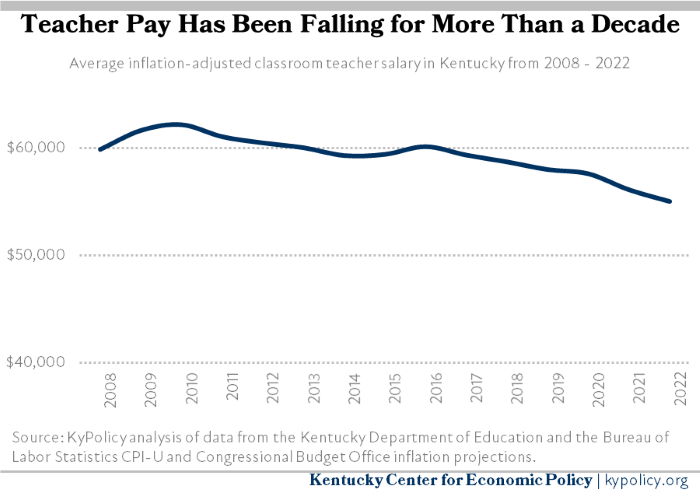
When looking at the district level, average inflation-adjusted teacher pay has fallen much further in some districts. With one exception (Fayette County) teachers have seen a pay cut on average in every school district — ranging from -25.9% in Russellville Independent to -4.5% in Franklin County since 2008 as illustrated by the map below. (Click here for an analysis that includes an interactive version of the map below to see information for each school district.)
While teacher pay is funded through a combination of state and local sources, there is a large and growing gap in the resources available to districts in wealthy and poor areas of the state. This means that any substantial, mandated increase in school district employees’ pay will need to be supported with state resources.
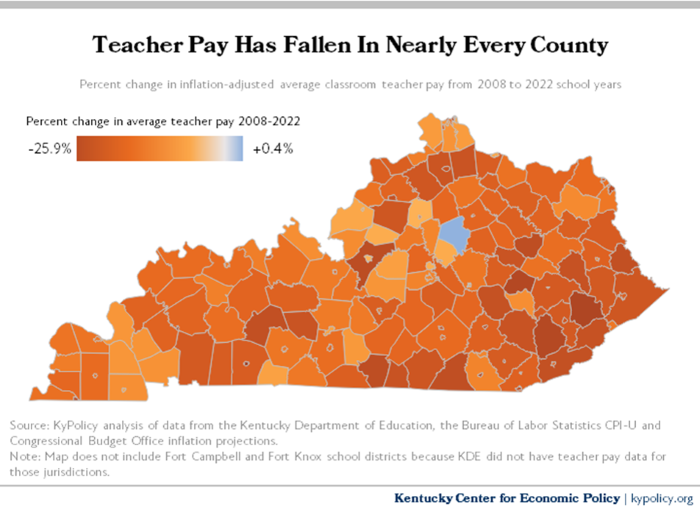
Current budget proposals differ in addressing school personnel salary increases
The Governor’s proposed budget for 2022-24 requires and provides funding for a minimum 5% pay increase for all school personnel and provides funding for a loan forgiveness program for teachers. The House budget recommends but does not require raises for school personnel but does include a $2,000 salary supplement each year for full-time Audiologists and Speech Language Pathologists and does not include a loan forgiveness program. Both budgets fully fund pension and medical benefits for teachers.
Funding for programs outside of SEEK also falls short
In terms of funding for education programs outside of SEEK, in the current budget there are no investments in instructional materials/textbooks or professional development, and these items have not received any state funding since 2018. Extended School Services (ESS) received no increased funding for the fourth year in a row, making funding 40% lower than it was in 2008 in inflation-adjusted terms. Funding for Family Resource and Youth Services Centers (FRYSCs) was flat-lined (at 17% below 2008 levels in inflation-adjusted terms), but then received $15 million from the Governor’s Emergency Education Relief Fund 2 (GEER II). The number of FRYSCs was expanded from 852 centers to 874 centers across the state with funding provided in the current year. The state invested $7.4 million to fund additional school-based mental health services provider positions on a reimbursement basis for 2022.
Current budget proposals provide funding for professional development and more funding for FRYSCs
Both proposed budgets provide some funding for professional development during the next biennium, and both provide additional funding for FRYSCs with the Governor providing an increase from $183.86 per eligible student to $200 per eligible student, and the House providing $220 per eligible student in each year of the biennium. Both budgets also provide funding for an early learning initiative and expanded funding for career and technical education, with the House budget providing significantly more funding for career and technical education. The Governor’s proposed budget also included funding for textbooks, and several other new programs not included in the House budget. Neither budget proposal provides additional funding for ESS. For easy comparison, the chart below provides information on current funding compared to proposed funding by the Governor and House in selected areas of the education budget.
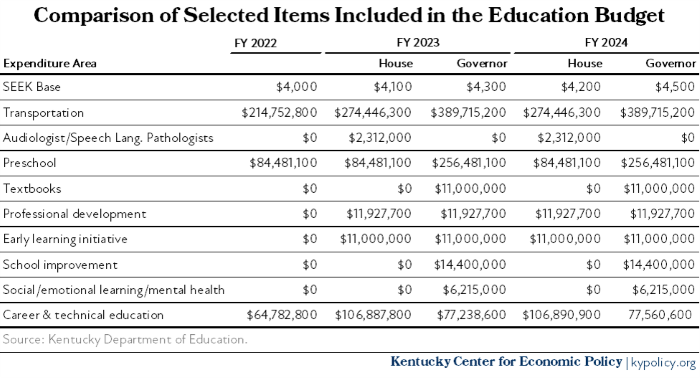
Although both the budget passed by the House and proposed by the Governor make more new investments in P-12 education than have been made in many years, we have fallen so far behind as a result of more than a decade of underinvestment that much more is needed. The good news is that there is money to do just that, but a great concern is that the legislature will choose instead to spend a large amount of these resources on cutting income taxes further — a policy choice that delivers huge cuts to millionaires in Kentucky but undermines investments in schools and other critical services.
For sources, citations and more information about the information provided in this article please follow these links:



